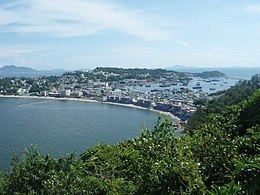Highest elevation 95 m (312 ft) Population 23,000 (2006) | Area 2.46 km (0.95 sq mi) Highest point Cheung Chau Elevation 95 m | |
 | ||
Coordinates 22°12'32.0"N, 114°01'45"E Points of interest Kwan Kung Pavilion, Yuk Hui Temple, Cheung Chau Rock Carvings, Kwun Yam Wan Beach, Cheung Chau Mini Great Wall Similar Lamma Island, Lantau Island, Peng Chau, Tai O, Hei Ling Chau | ||
Cheung Chau (Chinese: 長洲, lit. "Long Island") is an island 10 kilometres (6.2 miles) southwest of Hong Kong Island. It is nicknamed the 'dumbbell island (啞鈴島)' due to its shape. It has been inhabited for longer than most other places in the territory of Hong Kong, and had a population of 22,740 as of 2011. Administratively, it is part of the Islands District.
Contents
- Map of Cheung Chau Hong Kong
- Best seafood in cheung chau 2016
- Geography
- Economy
- History
- Temples
- Others
- Bun Festival
- Notable people
- Education
- Transportation
- References
Map of Cheung Chau, Hong Kong
Best seafood in cheung chau 2016
Geography
Geographically the island is formed from two mostly granite masses joined by a tombolo. With an area of 2.45 square kilometres (0.95 square miles), the island is therefore "long", hence the name as translated from Cantonese is "Long Island". Thus, it is redundant to say "Cheung Chau Island". The island is dumbbell-shaped, with hills at the northern and southern ends and the settlements concentrated in between.
Economy
The central part of the island is well developed with shops and houses. The lane-ways are so narrow that normal motor traffic is impossible. Instead, there are small motorised trucks officially termed "village vehicles". For example, there are small specially designed mini-fire engines, ambulances and police cars. Residential areas also exist on the hills of the north and south.
Traditionally the island was a fishing village and there are still fishing fleets working from the harbour. However, in recent years the island has become a major tourist attraction, offering a mixture of sandy swimming beaches, seafood cafés, and traditional Chinese culture.
History
Under the terms of the 1898 Second Convention of Peking, the New Territories and 200 smaller islands including Cheung Chau were leased to the United Kingdom for 99 years. At that time, Cheung Chau was mainly a fishing village; it had more residents living on junks than on land. Cheung Chau had already been settled by people from other places in Southern China; for example, Hoklo, they are mainly fishing people; Hakka people; Chiu Chau; and Yue Ca. The island slowly evolved into a commercial hub with merchants selling supplies to the local fishing people, boat repair and fishing gear as well as the place to do business for fishing people and small farmers of other nearby islands like Lantau Island.
From 2000, a spate of suicide cases (most of them by "burning charcoal") took place inside rental holiday homes on the island. Hong Kong Chinese-language newspapers soon dubbed the island "Death Island" and stories concerning apparitions appeared in the wake of news about the succeeding suicides. In 2005 a local councillor Lam Kit-sing (林潔聲) proposed a "suicide theme-park" to be built to capitalise on the island's now macabre reputation. Those plans were quickly ridiculed and subsequently rejected. Soon after, the choice of Cheung Chau for would-be suicides tailed off.
Temples
Temples on Cheung Chau include:
Others
Bun Festival
The annual Cheung Chau Bun Festival is a festival which includes a parade of floats, most famously including young children dressed as famous characters doing impossible balancing acts. It last three to four days and attracts tens of thousands of visitors to the island.
Notable people
Education
There are four primary schools and two secondary schools in Cheung Chau, including C.C.C. Cheung Chau Church Kam Kong Primary School, Cheung Chau Fisheries Joint Association Public School (closed), Cheung Chau Sacred Heart School, Kwok Man School, Buddhist Wai Yan Memorial College and Cheung Chau Government Secondary School.
Transportation
First Ferry operates ferries service between Central pier number 5 and Cheung Chau. The ferries run approximately every 30 minutes depending upon time of day. Schedules on Sundays and public holidays differ from weekdays. The trip of about 20 kilometres (12 miles) takes 55 minutes or 35 minutes for ordinary ferries and high speed ferries respectively. Ferries operated by Maris Ferry to Aberdeen are also available. Due to inaccessibility to cars and other vehicles, most residents use bicycles for personal transportation, and a number of bicycle rental shops near the ferry pier rent bicycles to tourists.
